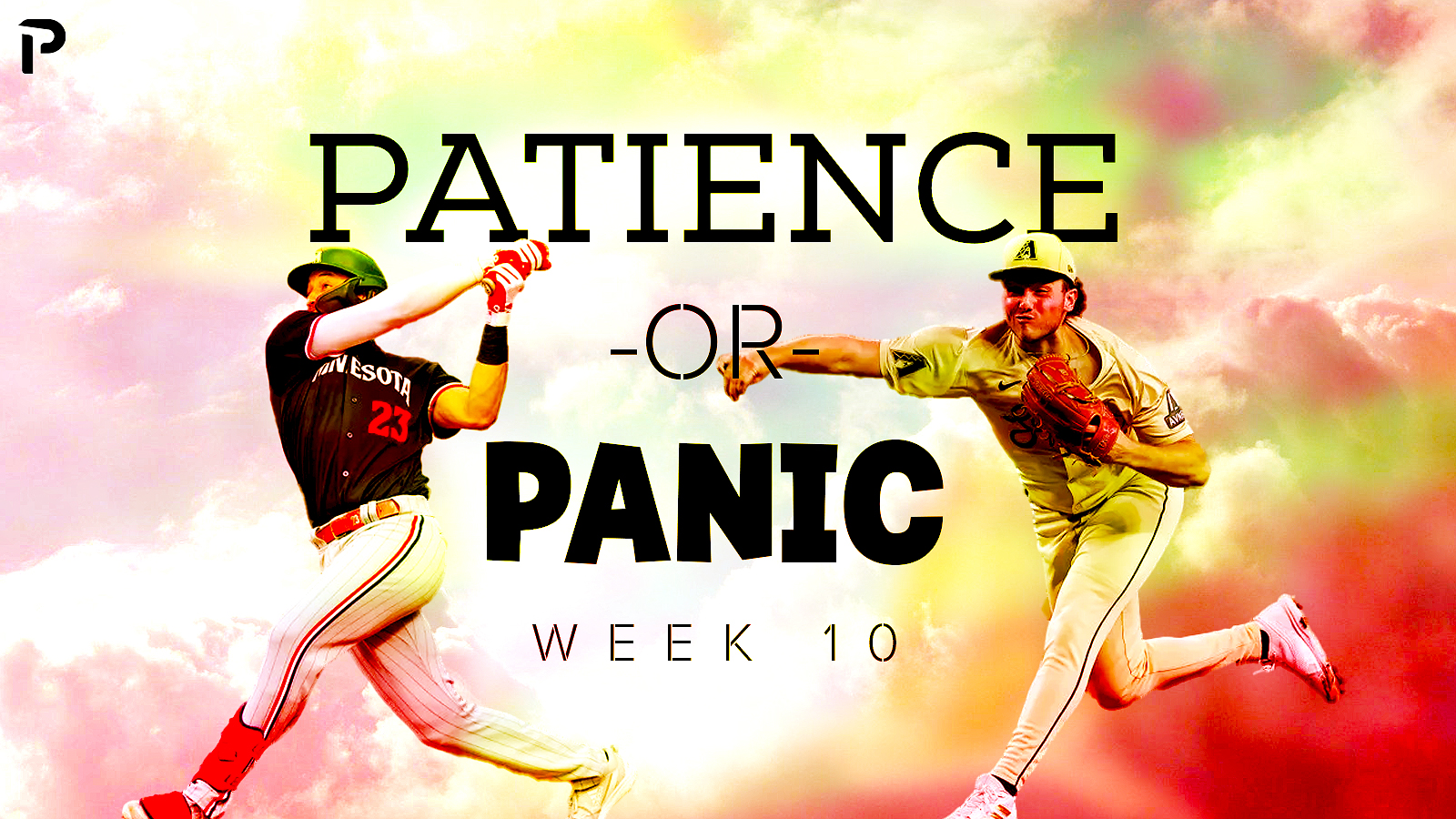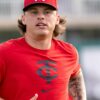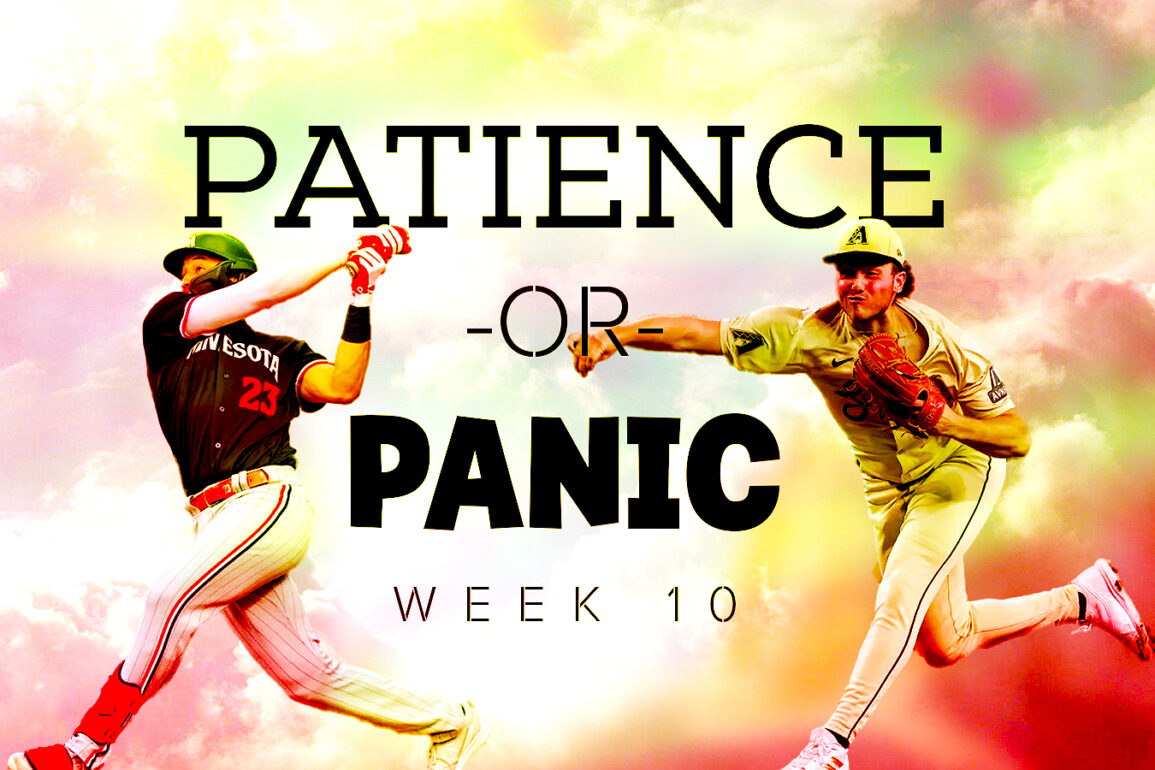
Welcome back to Week 10 of our Patience or Panic series, where we profile three struggling players and provide recommendations on how you should react to their poor recent performance. I am back on the beat after a few weeks off. Thanks to Griffey Geiss for covering in the meantime with some good breakdowns! In Week 9, he examined Kristian Campbell (Patience), Jackson Chourio (Patience), and Zac Gallen (Panic). Chourio had a monster weekend, going 8-15 with six runs, six RBIs, and one homer and steal each against the Phillies. He’s roughly on pace for a 20/25 season but might fall short of his steep draft day price if he doesn’t have more weekends like that.
This week, I will be breaking down three players that aren’t quite as heralded as Chourio and Gallen but have had spells of significant fantasy value. We saw some pitchers get shelled this weekend, so this series offers a good opportunity to look into their performances and hypothesize how concerned we should be. All stats are through the games of Monday, June 2.
Royce Lewis, 3B, MIN
Last 30 days: 77 PA, .125/.195/.197 (10 wRC+), 4 R, 1 HR, 3 RBI, 0 SB
I don’t need to include the season-long numbers for Lewis because they are the same as what he’s done the last month. He got a late start after suffering a hamstring strain in Spring Training and made his season debut on May 6. I’m honestly surprised that his 10 wRC+ is only the third-worst among qualified hitters since that date, ahead of Luis Robert Jr. (8 wRC+) and last week’s cover boy, Kristian Campbell (-6!). This enormous slump represents a continuation of last year’s sputtering finish for Lewis. He hit .207/.270/.350 (74 wRC+) with six long balls in 58 second half games. The season long line was still a serviceable .233/.295/.452 with 16 HRs in 82 games. While the batting average was disappointing, the power was clearly still there. This year, it has all disappeared. The biggest risk with Lewis going into this year seemed to be his injury prone nature. Few people had serious doubts about his ability to produce when on the field, but now that has also come into question.
I know I threw a ton of numbers at you in the chart above, but bear with me here. Lewis’ swing decisions (O-Swing% and Swing%) are almost the exact same as they were in his impressive but injury-shortened 2023 campaign, when he slashed .309/.372/.548 with 15 HR in 58 games. His ability to make contact in the zone has actually improved slightly since then. As a result, the walk rate is similar, and the strikeout rate has decreased. Lewis’ barrel rate is down, but because he’s striking out less, his barrel rate per plate appearance is only slightly lower. He’s even hitting his flyballs just as hard as 2023! That brings us to the Pull Air%, which is now displayed on Baseball Savant player pages. This tells you what percentage of a player’s batted balls are pulled flyballs, which are the type of batted balls that turn into home runs most often. Lewis has completely stopped pulling the ball in the air this year, going from well above the league average of 16.6% to well below it. His expected slugging and expected wOBA have tanked as a result, with almost none of his flyballs netting homers. That rate has collapsed from 38.5% in 2023 and 25.4% in 2024 to 3.4% this year.
Verdict: Patience (in dynasty and deeper redraft formats). I want to make it clear that just because I am recommending patience here doesn’t mean I think Lewis is likely to return his draft day value. That ship has probably sailed. In terms of performance, it doesn’t get much uglier than this, but aside from the pull rate, Lewis’ core skills remain intact. He has been so terrible that you can freely cut him in shallower redraft formats, but keep an eye on how Lewis is doing once you do. There’s clearly some bad luck going on. I didn’t even mention his absurdly low .138 BABIP in my massive chart, but that’s kind of a given with someone hitting .125 and not striking out a lot. I just don’t buy that Lewis is somehow now incapable of pulling flyballs when he hasn’t lost much ability to make contact or to hit the ball hard and isn’t just flailing at everything up there. This could be the result of some unreported injury that has affected his swing mechanics, but I’m not going to speculate. With the Twins now almost fully healthy and hoping to compete, they will be sitting Lewis once or twice a week to get better performing bats in the lineup. This will hurt his value and make him cuttable in shallower formats, but I don’t think it’s a good time to sell low in deeper redraft formats or keeper/dynasty leagues.
Brandon Pfaadt, SP, ARI
Last 6 GS (since 5/3): 2-3, 26.2 IP, 20 Ks, 8.10 ERA, 1.57 WHIP
2025: 7-4, 62.1 IP, 49 Ks, 5.05 ERA, 1.32 WHIP
This rough stretch for Pfaadt was punctuated with a start on May 31 against the Nationals that is every pitcher’s worst nightmare. He failed to record an out, allowing eight earned runs on six hits and two HBPs. Interestingly, he didn’t allow a single home run. You can’t ever predict an outing this bad, but it was only a matter of time before regression came for Pfaadt. The alarm bells started going off for me when he failed to record a single whiff in a quality start against the Dodgers on May 19. I can’t say I’ve ever seen that before, much less in an outing that actually went alright. The lack of whiffs has been a characteristic of Pfaadt’s entire season, as his 18.2% strikeout rate and 10.7% SwStr% are well below his respective career marks of 22.6% and 12.1%, neither of which were above average to begin with.
The biggest difference I can find between the 2025 Pfaadt and the Pfaadt of years past is that his sweeper, typically his best offering, is not getting the job done. I know I’ve spit out another unwieldy chart, but I promise this one makes sense, too. The velocity, induced vertical break (iVB), and induced horizontal break (iHB) on Pfaadt’s sweeper haven’t changed much between 2024 and 2025, which tells me that the shape of the pitch isn’t all that different. What we have seen is that Pfaadt is throwing it in the zone significantly less (41.7% vs 36.6%) and getting fewer chases (38.4% vs. 33.8%). This has caused the strike rate on the pitch to drop significantly, (65.4% to 60.9%) and the decline in chase has also caused the swinging strike rate to plummet (19.1% vs. 14.7%). Along with earning fewer strikes, the sweeper is getting hit much harder when it is put into play, as shown by the 13 percentage point jump in hard hit rate and 0.402 xwOBA. The performance of the pitch isn’t actually bad, but it’s not good enough for what has historically been Pfaadt’s go-to pitch. None of his other four offerings have a PLV higher than 5.08, so he’s really lacking a true out pitch right now.
Verdict: Panic. I have some faith in Pfaadt to get the feel of his sweeper back and execute it better because the pitch’s characteristics haven’t changed much, but that’s more of a prerequisite for him to have any success rather than something that will unlock a new level. Through 340 career MLB innings, he’s 21-23 with a 5.06 ERA, 1.30 WHIP, and 328 strikeouts. When the whiffs start to dry up for a guy who is already a ratio risk, you don’t need to hold him on your fantasy teams anymore. Pfaadt is firmly in streamer territory for me in 12 team leagues and shallower, and I’m being selective about where I start him in 15-teamers too. I would expect a low- to mid-4.00s ERA and 1.25 WHIP the rest of the way. Hopefully you can get better than that if you pick your spots wisely.
Jesús Luzardo, SP, PHI
Last 5 GS (since 5/8): 2-1, 28.2 IP, 34 Ks, 5.96 ERA, 1.57 WHIP
2025: 5-1, 70.1 IP, 81 Ks, 3.58 ERA, 1.34 WHIP
I have Luzardo’s stats from his last five starts totaled above, but it’s really his most recent one that earned him the feature today. Luzardo was 5-0 with a sparkling 2.15 ERA before getting lit up to the tune of 12 earned runs in 3.1 IP against Milwaukee on May 31. The start was the only time Luzardo has allowed more than three runs all season. Prior to this blowup, he was right up there with Kris Bubic and Tyler Mahle as one of the best late-drafted arms of the season.
Luzardo has had long spells of borderline fantasy ace-level performance in the past, only to ultimately regress to the epitome of a Cherry Bomb. This outing shows us that risk hasn’t entirely disappeared, but Luzardo has made some changes from a poor 2024 (66.2 IP, 58 Ks, 5.00 ERA, 1.25 WHIP) that make me think this outing is more of a blip than a sign of things to come. For one, his velocity is up at least a tick across the board, in line with where it was during 2022 and 2023, his two best seasons. He also has a new weapon to work with: a sweeper. The pitch grades out fantastically (5.42 PLV), and he has leaned on it a ton against lefties. Against batters of the same handedness, Luzardo throws the pitch 51.6% percent of the time, and it’s registered a 43.4% CSW% and 0.142 xwOBA. That’s about as good as it gets. The sweeper has been worse against righties but still pretty effective (19% Usage%, 46.7% CSW%, 0.280 xwOBA). Because the sweeper is vulnerable to hard contact against opposite-handed hitters, he still lacks a consistent recipe against righties, with only the sweeper grading out above a 5.10 PLV. This likely puts an SP 2/3 ceiling on Luzardo, but that’s great for what you paid on draft day.
Verdict: Patience. Unlike with Pfaadt, this outing wasn’t a manifestation of problems Luzardo had been experiencing all season. Luzardo’s velocity was still there in this dud outing, and he’s made some real improvements to his repertoire this season. The 1.34 WHIP is detrimental, but I think it will come down a bit while you continue to get a decent ERA and lots of strikeouts, wins, and quality starts. The schedule doesn’t ease up, as his next two starts are against the Blue Jays and Cubs, but you can’t sit Luzardo unless you’re protecting ratios in a head-to-head matchup and have little to gain from the upside he offers.
This post was originally published on this site be sure to check out more of their content.







